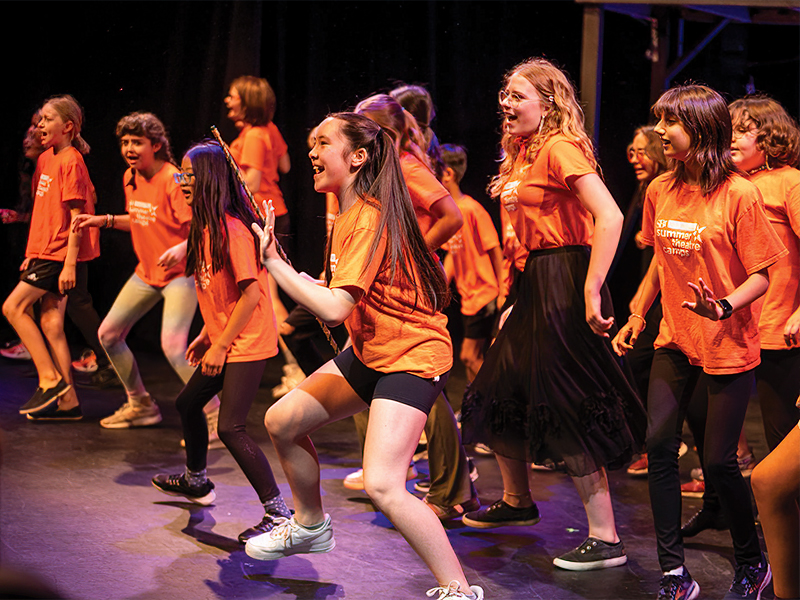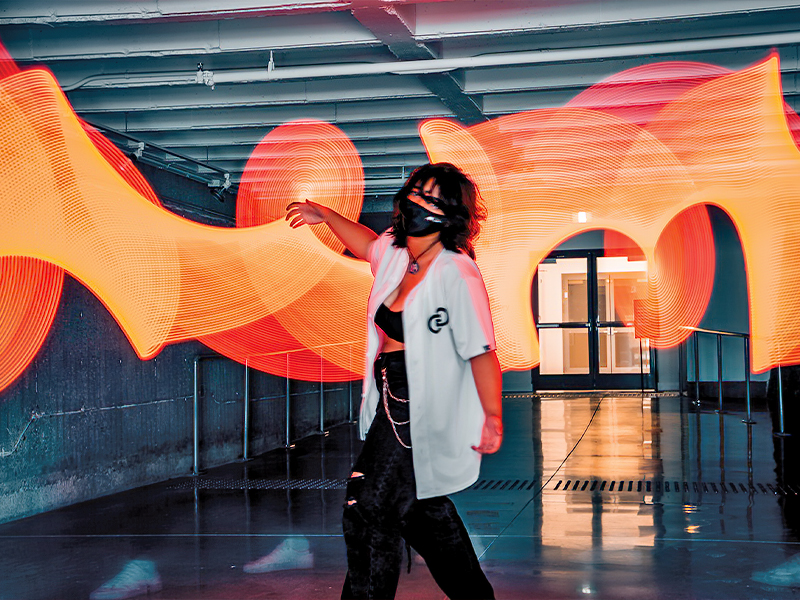Reimagining Arts Education
Giving kids access to art develops critical life skills, helps build identify and creates connection to community.

Artist Autumn Whiteway visits a school classroom to teach students about woodland art and share Indigenous ways of knowing
and understanding | Photo courtesy of Kiani Evans
Giggling children with jellyfish puppets dangling from sticks parade through Arts Commons on their way to Olympic Plaza, where they work together to animate their creations. A group of young people stand on the Martha Cohen Theatre stage as a flurry of snowflakes is released from above using a snow bag and the theatre’s fly system. Artist Autumn Whiteway visits a school classroom to teach students about woodland art and share Indigenous ways of knowing and understanding.
These arts experiences provide more than joy and memorable moments. They create opportunities for creativity, curiosity and collaboration. They build problem-solving skills, confidence and resilience. They promote self-expression and empathy.
UNESCO (United Nations Educational, Scientific and Cultural Organization) recognizes art as an essential component of a comprehensive education. It also sees the arts playing an important role in shaping a future society where those skills are needed.
“The arts have a higher purpose — and the more accessible and inclusive, the better,” says Karen Youngberg, associate director of education at Arts Commons. “This is about the arts being a human right. The arts help build identity and connection to community, so if we don’t build accessible arts programming [for young people], a whole generation is going to miss out.”
In 2022, a benchmark survey about the perceived value of arts education led by Arts Commons found that accessibility was identified as a barrier to arts education by 32 per cent of parents. And schools can’t always fill those gaps — Youngberg says there’s not always dedicated funding for field trips into the community or to bring artists into the schools. The survey also found that 40 per cent of parents don’t consider arts experiences for their kids — it’s just not on the radar. “That’s a huge challenge,” she says. “We need to start disrupting the way people are thinking and viewing arts education.”
Arts Commons launched Arts ReimaginED in 2023 to change the conversation about arts education with parents, educators, students and teaching artists in the community. Held to coincide with the UNESCO International Arts Education Week in May, the program offered free arts education programs for youth in every quadrant of the city, including all YMCAs and 120 classrooms. “We’ve already had schools reach out to us about creating a year-long program with them,” says Youngberg. “Teachers saw the immediate impact of the artists working with students. The scope of this is going to grow. We know the demand is there. It’s about creating the change as a community.”
Knowing the demand exists is one thing, but understanding what people want is another. Alex Sarian, president and CEO of Arts Commons, says it’s critical for arts organizations to listen to parents and educators, evaluate their existing programs and make changes that meet the community’s needs rather than continuing down the same path and slowly losing audiences. “What we want for our young people is so disconnected from the experiences we’re providing them,” he says. “Once we crack the nut of inspiring demand for arts education, we can start talking about how to provide these experiences.”
The next step, says Youngberg, is to continue those conversations started with Arts ReimaginED collaborators. Arts Commons has committed to helping educators successfully use the arts as a foundation for teaching in the classroom, including partnering them with independent teaching artists from the community and activating community halls, YMCAs and other shared spaces with arts programming to provide accessible experiences for youth.
“Calgary is so full of amazing artists, we’re so lucky,” Youngberg affirms. “We have to do this together. There’s only one way through this and it is with community.”
Three Organizations Using Art to Empower Youth

Students in the SBT Theatre Program dancing onstage | Photo courtesy of StoryBook Theatre
Storybook Theatre
Since 1977, thousands of Calgarians have walked through the doors of StoryBook Theatre (SBT) to attend its classes and performances. Started by a school teacher passionate about drama, SBT has stayed focused on family and youth programming from its first season at Pumphouse Theatre through to its upcoming 47th season at the Beddington Theatre Arts Centre.
SBT Theatre School program coordinator Cristina Lanz often meets people who participated in SBT’s programming who are now working professionals in fine arts and want to give upcoming students a positive theatre education experience like they had. “What’s really cool about how long StoryBook has been around is you can see the impact it’s had on the community over time,” says Lanz, a former SBT student herself.
The theatre school offers accessible and inclusive performing arts programs for about 800 young people annually. Lanz says students often leave with more confidence, better communication skills and a stronger sense of compassion as they learn to put themselves in other people’s shoes. “Even if they decide not to pursue the arts as a career, the skills that they learn will help them in whatever they decide to do in the future.”
Learn more at storybooktheatre.org.
Urban Society for Aboriginal Youth

Creating graphic novels using Blackfoot language | Photo courtesy of USAYUrban Society for Aboriginal Youth (USAY)
The Urban Society for Aboriginal Youth (USAY) started as a youth advisory committee under former Calgary Mayor Al Duerr in 1991, then became a not-for-profit organization two years later. Today, USAY offers programs co-created with Indigenous youth with the goal of establishing well-being and healthy futures through empowerment — and many of those programs involve art.
“The process of creating your own authentic stories in a meaningful way can be really healing,” says LeeAnne Ireland, USAY’s executive director. In one program, young people create graphic novels using the Blackfoot language and share traditional stories. In another, they enter a virtual reality escape room to help an Indigenous youth overcome challenges and find support. “There’s a major sense of accomplishment, confidence-building and a sense of worthiness. They learn that ‘My story matters. My art matters. I matter.’”
Learn more at usay.ca.
Antyx Community Arts

Youth participate in after-school programs at Antyx Community Arts | Photo courtesy of Antyx Community Arts
Antyx Community Arts encourages youth to use art to explore critical issues and make positive social change. Born from the merger of All Nations Theatre and Urban Youth Worx in 2010, Antyx offers free programming across the city, from Greater Forest Lawn in the southeast to Contemporary Calgary downtown.
Youth can participate in after-school programs, film labs or visual arts workshops. During the summer, Antyx offered a free seven-week summer program exploring the use of visual art through the decades as a catalyst for change. To get a sense of what young people can accomplish when given the opportunity to be creative, visit the new forest-themed mural facilitated by Antyx at the Genesis Centre in northeast Calgary.
Learn more at antyx.org.
This article was originally published in the 2023 edition of Create Calgary, an annual magazine launched by Calgary Arts Development in 2022 to celebrate the work of artists who call Mohkinsstsis/Calgary home.
You can pick up a free copy at public libraries, community recreation centres and other places where you find your favourite magazines. You can also read the digital version online here.

